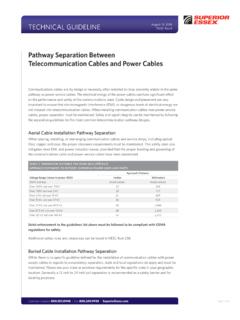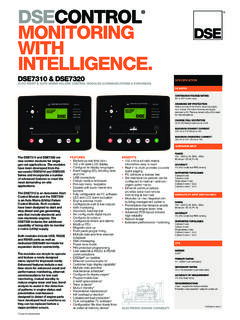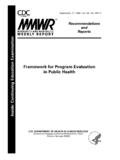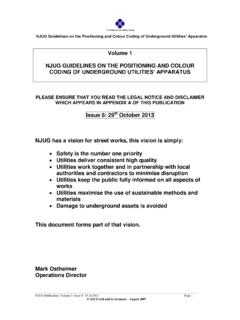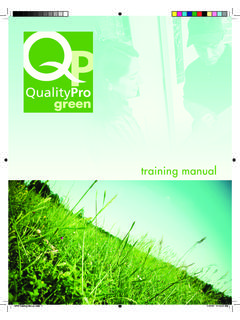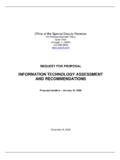Transcription of BY ORDER OF THE AIR FORCE INSTRUCTION 32 …
1 BY ORDER OF THE SECRETARY OF THE AIR FORCE AIR FORCE INSTRUCTION 32-10142 14 MAY 2013 Incorporating Change 2, 6 October 2016 Civil Engineering FACILITIES BOARD COMPLIANCE WITH THIS PUBLICATION IS MANDATORY ACCESSIBILITY: Publications and forms are available for downloading or ordering on the e-Publishing website at RELEASABILITY: There are no releasability restrictions on this publication. OPR: HQ AF/A4CP Certified by: HQ AF/A4C (Maj Gen Timothy S. Green) Pages: 15 This INSTRUCTION implements Air FORCE Policy Directive (AFPD) 32-10, Installations and Facilities and is consistent with AFPD 32-90, Real Property Asset Management. It provides guidance and INSTRUCTION for the installation Facilities Board and supporting working group.
2 It establishes the group membership, defines roles and responsibilities, provides broad timelines, and clarifies relationships to other planning, space management, and programming processes. This INSTRUCTION applies to all AF organizational entities, including the Air FORCE Reserve Command (AFRC) and Air National Guard (ANG) on an Air FORCE Installation. This INSTRUCTION is implemented at all AF installations that have responsibilities consistent with AFPD 32-10 and AFPD 32-90. Refer recommended changes and questions about this publication to the Office of Primary Responsibility (OPR) using the AF Form 847, Recommendation for Change of Publication; route AF Form 847s from the field through functional chain of command.
3 Ensure that all records created as a result of processes prescribed in this publication are maintained in accordance with Air FORCE Manual (AFMAN) 33-363, Management of Records, and disposed of in accordance with the Air FORCE Records Disposition Schedule (RDS) located in the Air FORCE Records Information Management System (AFRIMS). SUMMARY OF CHANGES The authorities to waive wing/unit level requirements in this publication are identified with a Tier ( T-0, T-1, T-2, T-3 ) number following the compliance statement. See AFI 33-360, Publications and Forms Management, for a description of the authorities associated with the Tier numbers.
4 Submit requests for waivers through the chain of command to the appropriate Tier 2 AFI32-10142 14 MAY 2013 waiver approval authority, or alternately, to the Publication OPR for non-tiered compliance items. An asterisk (*) indicates newly revised material. AFI32-10142 14 MAY 2013 3 Chapter 1 FACILITIES BOARD ROLES AND RESPONSIBILITIES Facilities Board (FB) Purpose. The Air FORCE depends on sustainable installations and facilities to effectively perform its missions and support its people. Sustainable installations provide required mission support in an economically efficient and compliant manner, leveraging available resources for the long-term benefit of the Air FORCE .
5 The FB acts as the installation s local decision-making body for the acquisition, construction, use, maintenance, modification, consolidation, development, demolition, and disposal of built and natural infrastructure at Air FORCE managed installations. The FB ensures an installation asset portfolio perspective is applied in all decisions and advisory actions. The FB is chaired by the Installation Commander (CC) or designated representative, and is supported by the Facilities Board Working Group (FBWG). Additional working groups/sub-working groups may be directed by the Installation Commander. The FB Chair has the authority to delegate responsibilities as appropriate.
6 At overseas locations, coordination with host nation liaison offices and/or host nation Forces/NATO representatives may be required. This INSTRUCTION does not delegate any authority to the Facilities Board which only may be exercised by the Installation Commander. This INSTRUCTION does not provide authorities to the Facilities Board for specific project/transaction approvals where existing AF policy mandates higher headquarters approvals. FB Responsibilities. The FB validates requirements and proposes solutions seeking the most effective and efficient course of action. The FB ensures the installation mission needs are effectively met with the minimum number of real property assets at the lowest life-cycle cost by implementing asset management principles.
7 The FB oversees and ensures the development, modernization and sustainment of the installation s built and natural infrastructure in accordance with the approved Installation Development Plan (IDP), the Base Comprehensive Asset Management Plan (BCAMP), and other plans as applicable ( Integrated Natural Resources Management Plan (INRMP), Air Installation Compatible Use Zone Study, Installation Complex Encroachment Management Action Plan (ICEMAP), etc.). The FBWG, at minimum, will: Validate the IDP, prior to Installation Commander endorsement, to ensure it accurately reflects the installation s current vision, goals, objectives and physical development as prescribed in AFI 32-7062, Air FORCE Comprehensive Planning, and is consistent with enterprise strategic direction as described in the annual Defense Planning Guidance and Air FORCE supplements.
8 (T-2) Approve the facility/project site requests as prescribed in AFI 32-7062. (T-2) Approve the summary for the installation s airfield waiver program IAW UFC 3-260-01. (T-2) Approve the installation facilities standards including the Architectural Compatibility Plan. (T-3) The FB provides installation wide oversight to maximize the AF value of existing built and natural infrastructure as defined in DoD INSTRUCTION , Real Property Inventory and Forecasting and AFI 32-9005, Real Property Accountability and Reporting; 4 AFI32-10142 14 MAY 2013 DoD INSTRUCTION , Real Property Management and AFI 32-9002, Use of Real Property ; DoD INSTRUCTION , Real Property Acquisition and AFI 32-9001, Acquisition of Real Property; and DoD INSTRUCTION , Real Property Disposal and AFI 32-9004, Disposal of Real Property.
9 The FBWG, at minimum, will: Approve the utilization of existing facility space in accordance with applicable space authorizations and standards ( consolidation and demolition opportunities, new space requests, etc.), to include all tenants. (T-2) Review and approve the proposed real property transactions, to include, in-grants/out-grants ( leases, enhanced use leases (EUL) and real property instrument requests). (T-1) Approve the recommendations on facility retention, use, divestiture, conversion, improvement, replacement, or acquisition. (T-1) Validate Readiness and Environmental Protection Initiative (REPI) submissions and other applicable installation-community initiatives.
10 (T-1) The FB reviews and approves the installation s BCAMP and supporting investment strategy ( MILCON, sustainment, restoration & modernization, etc.), to include project prioritization, for built and natural infrastructure. The FB considers the risk to mission and risk to Airmen service area criteria. Prior to approval, the FB must assess: Environmental, safety and occupational health (ESOH) risk, security risk and compliance with statutes, regulations, codes and standards. (T-0) Asset preservation and development (based on facility condition, mission dependency index, and local mission impact to include those validated by Defense Critical Infrastructure Program or through AF/MAJCOM/base key asset analyses).











